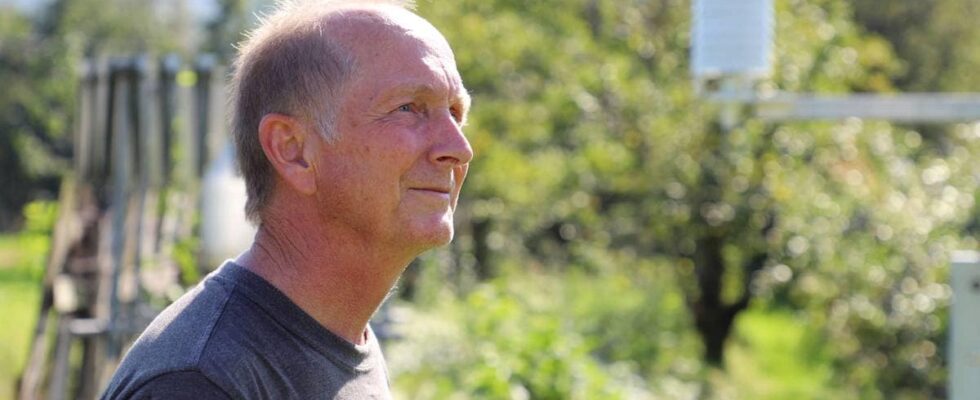– It was frightening and unexpected, says Lars Kjetil Flesland. He has been local host for the measuring station in Etne in Vestland for almost 30 years. On Thursday, he measured the hottest temperature ever measured in this country in September. Then it was 30.6 degrees in his garden. Is it a coincidence that the Norwegian record was taken right here? Hardly. – We have a favorable location. We are in the middle part, and do not get the cold sea breeze in. When the wind comes from the southeast, it gets nice and warm here, he says. FAVORABLE LOCATION: The measuring station in Etne is located in the middle of the village. At the same time, they are sheltered from the cold wind from the sea. This means that it will be nice and warm where the station is. Photo: Eli Bjelland / news – Bismak There are great contrasts on his farm, which is located in the middle of the village. There are autumn colors on the trees. On the ground, the hay is dry. – It has been a wet summer, so we appreciate getting in the last part of the crop. At the same time, it gives an aftertaste. I am frightened by climate change, says Flesland. CROPS: The farmer appreciates that he gets another crop after a wet summer. Ideally, he would have had stable seasons. In recent years, he has started growing heat-demanding plants, such as maize. Photo: Eli Bjelland / news More gray weather days His farm is located right by the Etnee river. He fears what will happen to the farm if we get wetter and wilder weather in the future. – That river is powerful, he says seriously. When you measure the weather for several decades, you notice the climate changes. And he states: The gray weather days have increased. It rains around 150 millimeters more from April to October now than it did when the measuring station was installed. – As a farmer, I would prefer to have the seasons as they should be. I want stable weather. TROPICAL DAY: Never before has a tropical day been measured in September, i.e. a day with 30 degrees or more. – I fear wilder weather, says Lars Kjetil Flesland, who is the local host for the measuring station in Etne. Photo: Eli Bjelland / news From one extreme to the other The new heat record in Etne is two degrees warmer than the previous record. It was 28.6 degrees, and was measured in Drammen in 2021. – Most records are broken by one tenth. That the leap is so big is sensational, says climate researcher Jostein Mamen at the Meteorological Institute. – We are pretty sure that it is humanity, global warming that is the cause, he says. This year’s summer is the hottest ever recorded by the EU’s climate monitoring service. “What the hell is going on?” Director Kikki Kleiven at the Bjerknes Center confirms that the wet and warm weather in Western Norway in recent weeks shows that climate change is happening here, too. – In one week we have gone from the wettest August ever to heat records the following week. We quickly go from one extreme to the other, she says. In August, a new rain record was set in Bergen. It was also the wettest August ever in Vestland. Kleiven says that our seasons are changing. Temperatures will be higher both early and late in the year. At the same time, rainfall is increasing in our part of the world. The extremes occur faster and in places where they have not happened before. – My colleagues are wondering “what the hell is going on?”. Because we are on our way into unknown terrain, it will be more difficult to report the weather and extremes, says Kleiven. That’s why Europe is getting warmer Heat waves in Europe come more often, last longer, and reach higher temperatures than before. Researchers are now clear that this is largely due to man-made greenhouse gas emissions. Swipe to read more about how summers have changed, and what we can do with it. AP How much warmer it has become The probability of heat waves in the world is almost three times as great now, as it was before the industrial revolution. In recent years, large parts of Europe have had maximum temperatures around 10 degrees warmer than normal. AP Every degree counts Scientists have been studying human influence on the climate since the early 20th century, and the evidence has grown stronger since then. Nevertheless, the world’s emissions have continued to increase. If global warming reaches 2 degrees, the number of heat waves in the world will probably double from today’s level. 4 degrees of warming can double the number of heat waves once more, according to the UN climate panel. But now something is happening. AP Is there hope? It may be that the world has finally reached the emission peak. The less greenhouse gases we release, the less these changes will continue to escalate. Many big cities have also become better at handling heat waves. Such measures have already meant that fewer people die from the heat than they would otherwise. HeyHey! Did you think about anything when you read? Or do you have other tips for matters? I would be very happy for an email. Published 06.09.2024, at 19.24
ttn-69
– Frightening and unexpected – news Vestland

